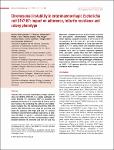Chromosomal instability in enterohaemorrhagic Escherichia coli O157:H7: impact on adherence, tellurite resistance and colony phenotype.
Bielaszewska, Martina
Middendorf, Barbara
Tarr, Phillip I.
Zhang, Wenlan
Prager, Rita
Aldick, Thomas
Dobrindt, Ulrich
Karch, Helge
Mellmann, Alexander
Tellurite (Tel) resistant enterohaemorrhagic Escherichia coli (EHEC) O157:H7 is a global pathogen. In strain EDL933 Tel resistance (Tel(R) ) is encoded by duplicate ter cluster in O islands (OI) 43 and 48, which also harbour iha, encoding the adhesin and siderophore receptor Iha. We identified five EHEC O157:H7 strains that differentiate into large (L) colonies and small (S) colonies with high and low Tel minimal inhibitory concentrations (MICs) respectively. S colonies (Tel-MICs ≤ 4 µg ml⁻¹) sustained large internal deletions within the Tel(R) OIs via homologous recombination between IS elements and lost ter and iha. Moreover, complete excision of the islands occurred by site-specific recombination between flanking direct repeats. Complete excision of OI 43 and OI 48 occurred in 1.81 × 10⁻³ and 1.97 × 10⁻⁴ cells in culture, respectively; internal deletion of OI 48 was more frequent (9.7 × 10⁻¹ cells). Under iron limitation that promotes iha transcription, iha-negative derivatives adhered less well to human intestinal epithelial cells and grew slower than did their iha-positive counterparts. Experiments utilizing iha deletion and complementation mutants identified Iha as the major factor responsible for these phenotypic differences. Spontaneous deletions affecting Tel(R) OIs contribute to EHEC O157 genome plasticity and might impair virulence and/or fitness.
No license information

